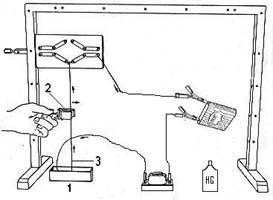

A week after the Oersted conference in Paris, André Marie Ampere, 21 years, professor of mathematics at Ecole Politechnique, began a series of experiments. In the following assembly at the Institut of France, he announced a new foundamental result: not only electric currents exert forces on permanent magnets and the permanent magnets exert forces on electric currents, but the electric currents also react between them.
Parallel copper wire attract or repel if the electric current has same direction or opposite direction.
Ampere understood that all the magnetism was electro-magnetism and that the properties of permanent magnets was due to the very little electric current flowing in them.
The glass dish is filled with mercury.
The electric current comes into the mercury in the basin 1 and enter the copper wire 3, after returns to the battery. Please see figure 1.
Around the wire now is a magnetic field that reacts with the permanent magnet. As result of the reaction wire 3 moves forward a bit.
The wire 3 is free to move because one end is immersed in the mercury and the other is hanging, not fixed.
The same result is obtained by reversing the current.